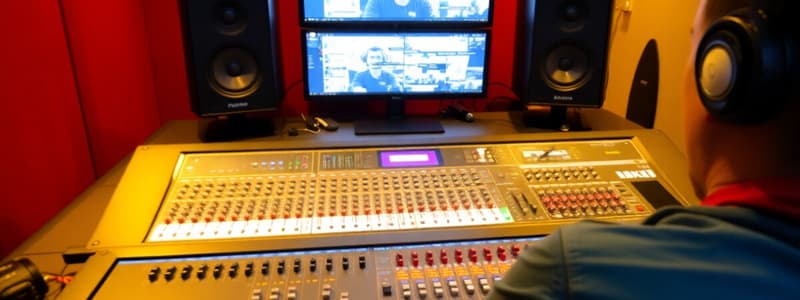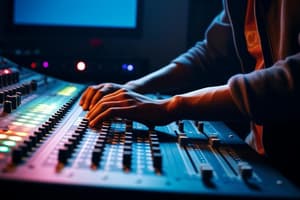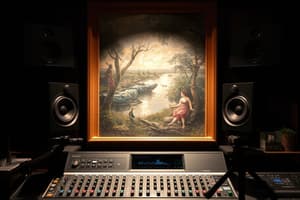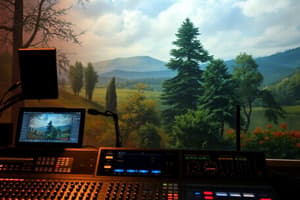Podcast
Questions and Answers
What are the two essential rules for arranging instruments to prevent conflicts?
What are the two essential rules for arranging instruments to prevent conflicts?
Limit the number of elements playing simultaneously and ensure each instrument occupies its own frequency range.
Name two starting points mentioned by mixing engineers for their mixes.
Name two starting points mentioned by mixing engineers for their mixes.
Lee DeCarlo suggests starting with the snare drum on the backbeat, while Don Smith recommends starting with kick and bass at -7VU.
Where is the primary focus when mixing dance music?
Where is the primary focus when mixing dance music?
The kick drum serves as the obvious starting point for mixing dance music.
Why is it important to monitor your master bus meters while mixing?
Why is it important to monitor your master bus meters while mixing?
How does using a comparison plugin like SampleMagic's Magic AB benefit mixing?
How does using a comparison plugin like SampleMagic's Magic AB benefit mixing?
Why is following logical naming conventions important in audio projects?
Why is following logical naming conventions important in audio projects?
What role do memory locations and window configurations play in mixing?
What role do memory locations and window configurations play in mixing?
What is the ideal setup for monitor speakers in relation to the listener's position?
What is the ideal setup for monitor speakers in relation to the listener's position?
How do subgroups enhance the mixing process?
How do subgroups enhance the mixing process?
What issues arise if monitor speakers are placed too close together or too far apart?
What issues arise if monitor speakers are placed too close together or too far apart?
Why is decoupling monitors from their surfaces essential?
Why is decoupling monitors from their surfaces essential?
What should be done with channels that use the same effects in a mix?
What should be done with channels that use the same effects in a mix?
Why are compressors typically used on kick, snare, bass, and vocal tracks?
Why are compressors typically used on kick, snare, bass, and vocal tracks?
Name two methods to decouple a monitor from its surface.
Name two methods to decouple a monitor from its surface.
What are some techniques to calibrate your hearing before mixing?
What are some techniques to calibrate your hearing before mixing?
List four reasons why mixing at high volume levels is discouraged.
List four reasons why mixing at high volume levels is discouraged.
What are some advantages of mixing at low volume levels?
What are some advantages of mixing at low volume levels?
What effect does closing your eyes while mixing have on auditory perception?
What effect does closing your eyes while mixing have on auditory perception?
Why is it essential to have a pen and paper ready during mixing?
Why is it essential to have a pen and paper ready during mixing?
Why is it useful to listen to a mix in mono?
Why is it useful to listen to a mix in mono?
What is a benefit of testing a mix on multiple speaker systems?
What is a benefit of testing a mix on multiple speaker systems?
How do mixers generally prefer to begin their mixing process?
How do mixers generally prefer to begin their mixing process?
What are the three essential steps in approaching a mix, and which is the most vital?
What are the three essential steps in approaching a mix, and which is the most vital?
What are the three dimensions that great mixers consider, and what does each dimension represent?
What are the three dimensions that great mixers consider, and what does each dimension represent?
How can a mixer create a deep dimension within their mix?
How can a mixer create a deep dimension within their mix?
What are some indicators of an amateur mix?
What are some indicators of an amateur mix?
List the six elements of a great mix and provide a brief definition for each.
List the six elements of a great mix and provide a brief definition for each.
What is typically the number one non-audio problem encountered in mixing?
What is typically the number one non-audio problem encountered in mixing?
What should be done to a song lacking a point of interest?
What should be done to a song lacking a point of interest?
What are two key actions you can take to improve your listening environment and overcome acoustic problems?
What are two key actions you can take to improve your listening environment and overcome acoustic problems?
Why is placing monitor speakers directly against a wall problematic?
Why is placing monitor speakers directly against a wall problematic?
What should you do first when receiving an original session file?
What should you do first when receiving an original session file?
What should always be trimmed from recorded takes to enhance audio quality?
What should always be trimmed from recorded takes to enhance audio quality?
What potential issue can arise from edits that lack crossfades?
What potential issue can arise from edits that lack crossfades?
What is a beneficial step to take once all edits and tuning are complete?
What is a beneficial step to take once all edits and tuning are complete?
Why is it essential to clearly label each track in a session?
Why is it essential to clearly label each track in a session?
What benefit does checking a mix on different monitoring systems provide?
What benefit does checking a mix on different monitoring systems provide?
Flashcards
Ideal Monitor Placement
Ideal Monitor Placement
The distance between the listener and each monitor should form an equilateral triangle, ensuring a balanced sound stage. The monitors should be at ear level when seated, preventing distortion. The monitors' angle should be adjusted to avoid smearing the stereo field and maintain a clear listening experience.
Monitor Spacing Impact
Monitor Spacing Impact
Placing monitors too close together can result in a narrow stereo field, lacking spatial definition. Conversely, monitors spaced too far apart can lead to a weak center image, as the 'sweet spot' might fall behind the listener.
Monitor Decoupling
Monitor Decoupling
Decoupling monitors helps reduce resonance, which can distort the sound, especially in the bass frequencies. This leads to a more accurate and balanced sound, making mixing decisions more reliable.
Monitor Decoupling Methods
Monitor Decoupling Methods
Signup and view all the flashcards
Mixing at High Volume
Mixing at High Volume
Signup and view all the flashcards
Mixing at Low Volume
Mixing at Low Volume
Signup and view all the flashcards
Mono Mix Check
Mono Mix Check
Signup and view all the flashcards
Multi-Speaker System Listening
Multi-Speaker System Listening
Signup and view all the flashcards
Arrangement
Arrangement
Signup and view all the flashcards
Mixing
Mixing
Signup and view all the flashcards
Reference Track
Reference Track
Signup and view all the flashcards
Volume
Volume
Signup and view all the flashcards
Mastering
Mastering
Signup and view all the flashcards
Balance in Mixing
Balance in Mixing
Signup and view all the flashcards
Dimension in Mixing
Dimension in Mixing
Signup and view all the flashcards
Panorama in Mixing
Panorama in Mixing
Signup and view all the flashcards
Most Important Mix Element
Most Important Mix Element
Signup and view all the flashcards
Interest in Mixing
Interest in Mixing
Signup and view all the flashcards
Dynamics in Mixing
Dynamics in Mixing
Signup and view all the flashcards
Frequency Range in Mixing
Frequency Range in Mixing
Signup and view all the flashcards
Signs of an Amateur Mix
Signs of an Amateur Mix
Signup and view all the flashcards
Why is it important to check a mix in mono?
Why is it important to check a mix in mono?
Signup and view all the flashcards
How to overcome acoustic problems in a studio?
How to overcome acoustic problems in a studio?
Signup and view all the flashcards
Why avoid placing speakers directly against a wall?
Why avoid placing speakers directly against a wall?
Signup and view all the flashcards
Why is it important to work on a copy of the original session file?
Why is it important to work on a copy of the original session file?
Signup and view all the flashcards
What should be trimmed in audio editing?
What should be trimmed in audio editing?
Signup and view all the flashcards
Why are crossfades important in audio editing?
Why are crossfades important in audio editing?
Signup and view all the flashcards
What should be done once all editing and processing is complete?
What should be done once all editing and processing is complete?
Signup and view all the flashcards
Why is it important to label tracks in a session?
Why is it important to label tracks in a session?
Signup and view all the flashcards
How do many engineers begin a mix?
How do many engineers begin a mix?
Signup and view all the flashcards
What are the major timesavers in a DAW?
What are the major timesavers in a DAW?
Signup and view all the flashcards
Why are subgroups useful for mixing?
Why are subgroups useful for mixing?
Signup and view all the flashcards
What should you do with channels using the same effect?
What should you do with channels using the same effect?
Signup and view all the flashcards
Why is compression important for kick, snare, bass, and vocals?
Why is compression important for kick, snare, bass, and vocals?
Signup and view all the flashcards
How do you calibrate your hearing for mixing?
How do you calibrate your hearing for mixing?
Signup and view all the flashcards
What happens when you close your eyes while mixing?
What happens when you close your eyes while mixing?
Signup and view all the flashcards
Why should you have pen and paper ready when mixing?
Why should you have pen and paper ready when mixing?
Signup and view all the flashcards
Study Notes
Monitoring Reading Assignment
- A good rule of thumb for placing monitor speakers is to create an equilateral triangle between the listener and the speakers, with the monitors at ear level.
- Placing monitors too close together may result in a narrow stereo field, while placing them too far apart may shift the center image.
- Decoupling monitors from their support surfaces reduces resonance and improves low-frequency response during mixing.
- This can be achieved by using stands, rubber feet, or filling stands with materials like sand or gravel.
- Mixing at high volume levels is discouraged due to ear fatigue, potential damage, skewed stereo imaging and false perceptions of the frequency balance.
- Mixing at low volumes helps maintain hearing health, accurately judge balance and identify small details more effectively, and translate the mix to other environments.
- Listening to a mix in mono helps identify issues like phase and balance.
- Using multiple speaker systems allows for a varied listening experience and checks to ensure that a mix translates to other environments.
- Addressing echo and reflections in the listening environment using room treatments such as diffusers and bass traps improves the mixing process.
- Avoiding placing monitors directly against walls reduces bass buildup in the listening environment.
- Working on a copy of the original session file and backing it up multiple locations (system, removable drive, cloud storage) safeguards against accidents.
- Trimming takes is necessary to remove extra audio from the beginning or end of recordings.
Labeling and Organizing Tracks
- Clear labeling of tracks enhances organization and recall as a project progresses.
- Using logical and consistent naming conventions is essential during collaboration.
Mixing Techniques
- Using memory locations and window configurations optimizes workflow in digital audio workstations (DAWs).
- Marking elements and adding pre-roll in DAWs are important time-saving mixing strategies.
- Using subgroups efficiently allows for adjusting multiple elements of a mix simultaneously (effects and compression).
- Routing and applying effects (equalization & compression) to related channels in a mixing environment improves efficiency.
Mix Calibration and Hearing
- Calibrating hearing before mixing involves minimizing exposure to loud sounds before mixing and properly adjusting the monitor level before starting a mix.
- Three-dimensional sound visualization is improved if you close your eyes during the mixing process, enhancing auditory awareness.
- Taking notes during mixing prevents loss of important information.
Mix Elements and Considerations
- Kick, snare, bass, and vocals often require compression in a mix to control their dynamics.
- The arrangement should balance the number of elements playing at the same time and place instruments within a specific frequency range.
- Identifying a point of interest (e.g., lead vocals, key instrument) to build around improves mix direction and interest.
Studying That Suits You
Use AI to generate personalized quizzes and flashcards to suit your learning preferences.





